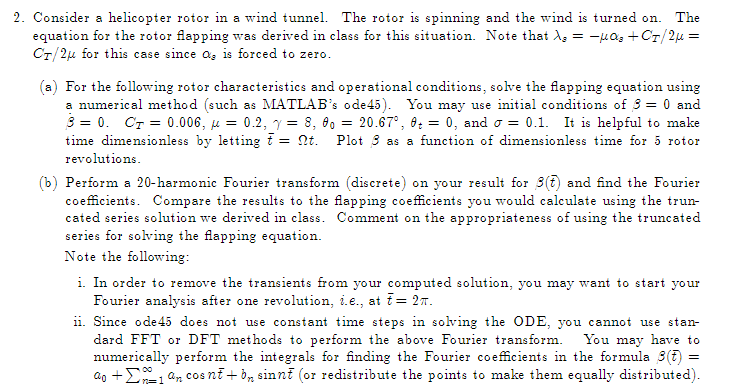Answered step by step
Verified Expert Solution
Question
1 Approved Answer
2. Consider a helicopter rotor in a wind tunnel. The rotor is spinning and the wind is turned on. The equation for the rotor

2. Consider a helicopter rotor in a wind tunnel. The rotor is spinning and the wind is turned on. The equation for the rotor flapping was derived in class for this situation. Note that = - +C/2 = CT/2 for this case since as is forced to zero. (a) For the following rotor characteristics and operational conditions, solve the flapping equation using a numerical method (such as MATLAB's ode45). You may use initial conditions of 3 = 0 and 30. CT=0.006, p = 0.2, y = 8, 80 = 20.67, t = 0, and = 0.1. It is helpful to make time dimensionless by letting = Qt. Plot 3 as a function of dimensionless time for 5 rotor revolutions. (b) Perform a 20-harmonic Fourier transform (discrete) on your result for s(t) and find the Fourier coefficients. Compare the results to the flapping coefficients you would calculate using the trun- cated series solution we derived in class. Comment on the appropriateness of using the truncated series for solving the flapping equation. Note the following: i. In order to remove the transients from your computed solution, you may want to start your Fourier analysis after one revolution, i.e., at t=2. ii. Since ode 45 does not use constant time steps in solving the ODE, you cannot use stan- dard FFT or DFT methods to perform the above Fourier transform. You may have to numerically perform the integrals for finding the Fourier coefficients in the formula 3(t) = ao +an cosnt + b sinnt (or redistribute the points to make them equally distributed). 00 12=
Step by Step Solution
There are 3 Steps involved in it
Step: 1

Get Instant Access to Expert-Tailored Solutions
See step-by-step solutions with expert insights and AI powered tools for academic success
Step: 2

Step: 3

Ace Your Homework with AI
Get the answers you need in no time with our AI-driven, step-by-step assistance
Get Started


